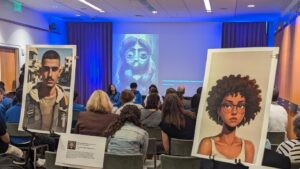The AI and Creative Arts Curriculum: What Every Student Should Know About AI and Art
June 23, 2025
Summary
Our "AI and the Creative Arts" curriculum, designed for students aged 8 and up, teaches about generative artificial intelligence and its role in artistic expression. It explains how generative AI creates images from data and prompts and emphasizes the importance of thoughtful engagement with AI. At a recent Day of AI event with Boston Public School students, students offered insightful perspectives on responsible AI use.
Why It Matters
Artificial intelligence is rapidly transforming countless industries, and the creative arts are no exception. From generating stunning visual pieces to composing music, AI’s presence in creative fields is growing and increasingly being recognized. Within this shift, the AI and the Creative Arts curriculum (for ages 8 and up) gives students the opportunity to explore how generative AI works and its potential role in artistic expression.
Originated by NYU Professor and MIT Media Lab Alum Safinah Ali, the goal of the curriculum is to equip students with practical knowledge of tools while fostering critical thinking around fundamental questions about creativity, ethics, and technology’s impact on society. The recent Day of AI event, featuring local Boston Public School students, proved just how vital this conversation is.
How it Works
At its core, AI is a computer program made by people that enables computers to perform tasks that seem intelligent. Generative AI, specifically, learns from vast datasets—collections of information like images, text, or numbers. Some of the datasets used to train text-to-image generators for art tasks include millions of images.
Generative AI learns patterns from these image datasets to generate new images. The key task it learns is how to turn noise into a high-quality image. First, the AI gradually “destroys” images by adding noise, step-by-step. Then, it learns to reverse this destruction by removing noise, step-by-step, to create new, unique images that never existed before.
This creative generation is largely controlled by the prompt given to the AI. Prompts are the specific instructions you provide to get a desired result or output. This highlights the importance of providing precise prompts to achieve specific results.
Students can best explore how generative AI works by employing it as a creative partner in creating artwork, such as self-portraits. Instructions for using age-appropriate image generation tools like ImageFX, Canva AI, Yarn, or KidGeni can be found in the free curriculum.
How to Engage with AI Thoughtfully

Participants listen in to the student panel at MIT’s 4th Annual Celebration of Day of AI at the Museum of Fine Arts.
While generative AI offers exciting opportunities, it’s crucial for students to understand its limitations:
- Bias in Generative AI Outputs: This was a significant topic at the Day of AI event, where students discussed how AI image generators, for example, often produce specific genders or races when given general prompts [1].
- Lack of True Creativity/Humanity: Generative AI works by identifying and replicating patterns in its dataset. Students noted that, though AI could create art beyond their capabilities, it could not achieve the same level of originality. They found that “human imagination really drives it,” especially in how the technologies relied on scraped human artwork.
- Inaccuracy/Imperfection: As students worked on their AI self-portraits, they encountered challenges with accuracy and representation in everything from hairstyles to appropriate backgrounds.
- Environmental Impact: Several students noted their concerns about the environmental footprint of AI given the massive energy and water-hungry data centers needed to keep models running.
Artists Have the Power
Our Day of AI event highlighted that students are intuitively aware of the promises and pitfalls of AI. When asked what every high school student should know about AI, their responses converged on crucial themes of agency and mindfulness. Lusibel P. emphasized that AI isn’t always the best or only tool, reminding peers that it’s okay to seek help when overwhelmed with assignments. Kayk D. stressed the importance of understanding how AI works, noting how it pulls from existing information rather than creating new work. Damaris R. added that students must be aware of AI’s limitations and imperfections, advising smart and discerning use of the technology. These students are not just users of AI, but thoughtful critics and innovators who understand its potential and its boundaries.
We encourage educators to explore the AI and the Creative Arts curriculum to bring these vital discussions into their own classrooms and empower the next generation of AI-literate artists and thinkers. The full event recording from the Day of AI will be available on YouTube soon, check back here!